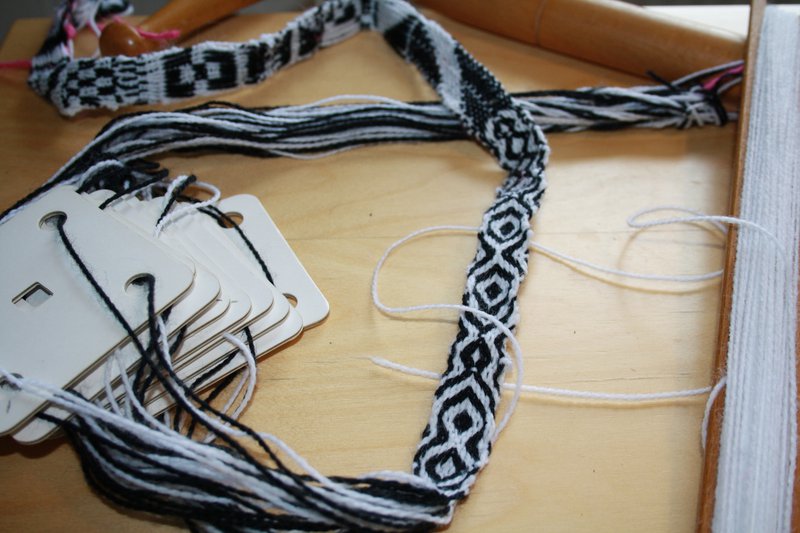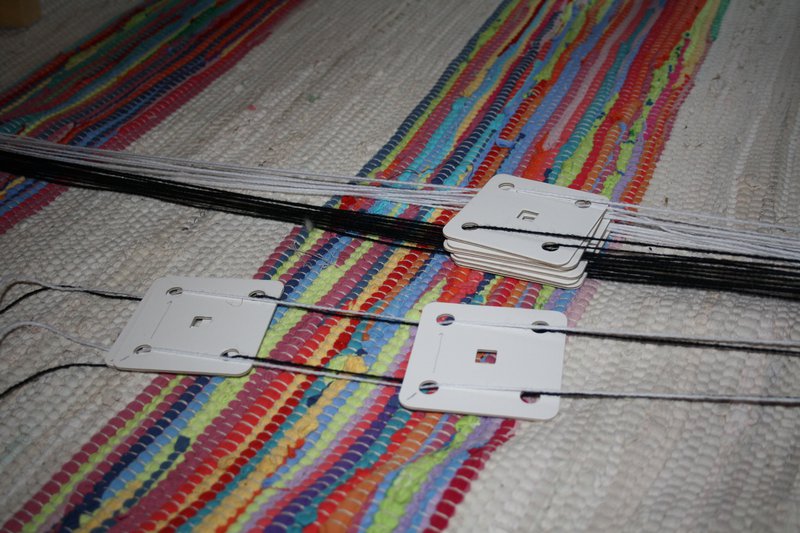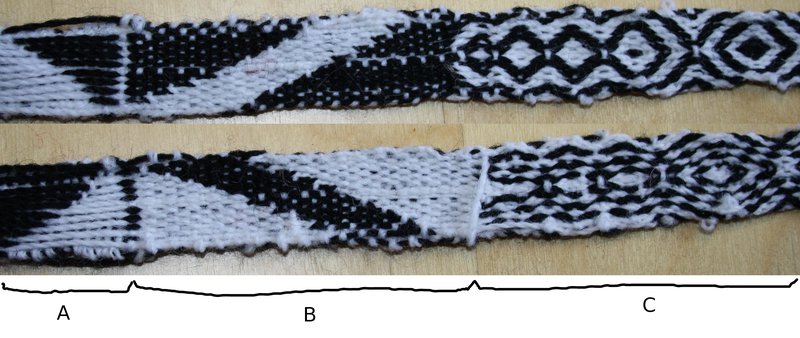Coding with threads: Tablet loom
Posted Feb. 6, 2015 by Dave GriffithsTablet weaving is an ancient form of pattern production using cards which are rotated to provide different sheds between warp threads. It's used to produce long strips of fabric, or the starting bands and borders that form part of a larger warp weighted weaving. We'll come to the second use later in the weaving codes project.

There are quite a few programs around to simulate the tablet weaving process - I used this program to get an initial understanding, here's an example screenshot:

When using square cards the convention is to name the holes a,b,c,d in clockwise order from the top left corner. The thread that is facing, so creating the colour is shown on the left. This program allows you to choose forward or back 90 degrees at a time for all the cards (the up/down arrows on the right) as well as flipping individual cards (the list of / and \ at the bottom). To start with I decided to try a double faced weave, using two colours. There is a good site that describes tablet weaving here. I chose this kind of setup as it's possible to create the warp using 4 continuous threads making it quite fast to get started.

The best weaving technique I found was to attach one end of the warp to a fixed object behind me and the other to a piece of wood I use to maintain tension with my feet, and pushing the weft threads away from me. There are many different ways to manipulate the cards to affect the structure created, most of the time you rotate all the cards 90 degrees either forward or back between each weft. There is a limit to how far you can go in one direction before the warp behind the cards gradually gets tangled up, so you need to maintain a balance. You can also flip them so they change direction in respect to the others and also the warp becomes twisted differently which affects the pattern. You can also rotate the cards forward and back individually too, although this doesn't seem to be used much. Here is a section of the tablet weaving I managed to produce, both sides are shown:

Section A was an attempt at direct pattern control, all the cards are matched up in terms of rotation, but I'm using flipping to change the 'facing' colour one by one to manually create a diagonal line. The process I was following consisted of turning forward 90 degrees, one weft, back 90 degrees one weft, then flip the individual cards and repeat. This unfortunately results in a bad structure with long floats. In section B I tried going forward one more turn before going back two. It took me a while to work this out as it means the same shed (and card configuration) actually creates different colours based on what you did in the previous step - this weaving has a memory! I need to look closer at the structure, or perhaps set up a huge tablet weaving with rope to figure out exactly what is happening here. This structure works much better than A, but notice the jagged edges on part of the diagonal - this is because the pattern is going against the twist direction of the warp in these sections. Section C is an indirect pattern technique, and much more satisfying - I changed the relative rotation of the cards at the end of section B, then rotated them all together 90 degrees back and forward throughout section C, the change in the pattern is down to the 'balance' of backs to forwards. The 'memory' effect smooths the pattern, and it always goes with the warp twist, but notice that with this technique the different sides of the fabric have a different pattern, it's not the inverse - I'm not clear exactly why this is yet.
Created: 15 Jul 2021 / Updated: 15 Jul 2021


